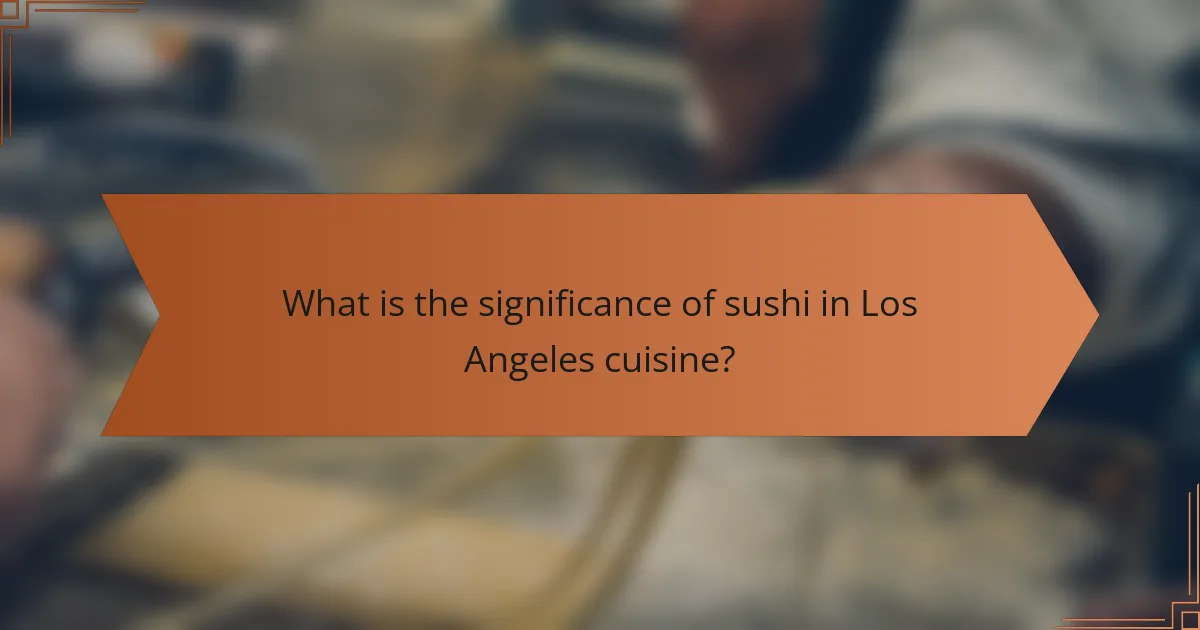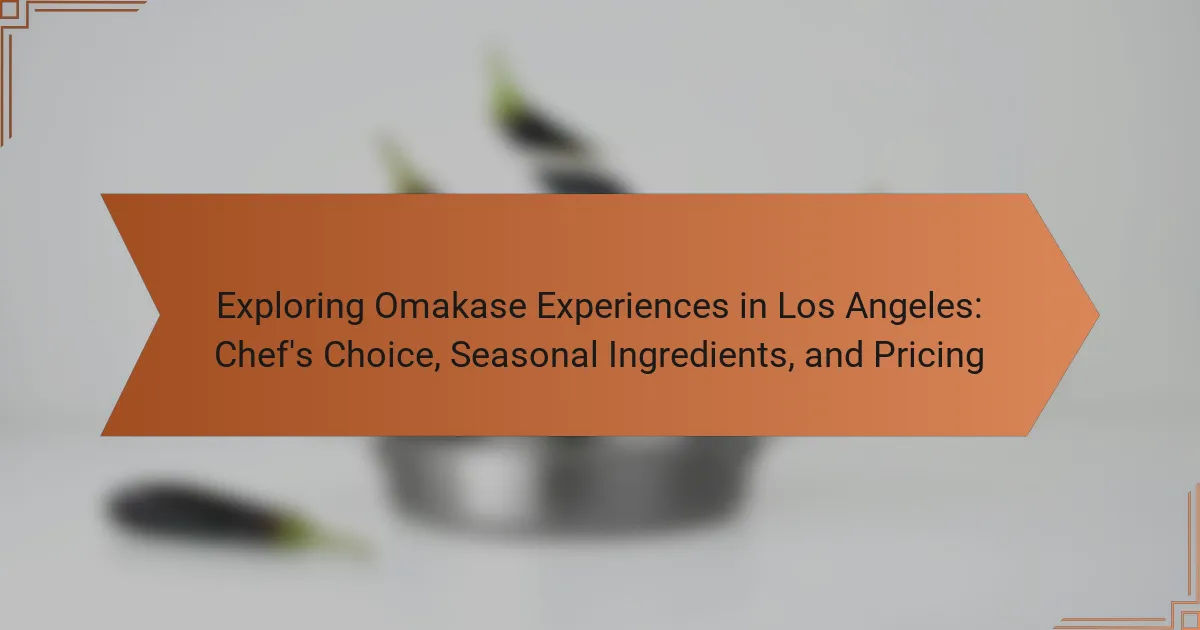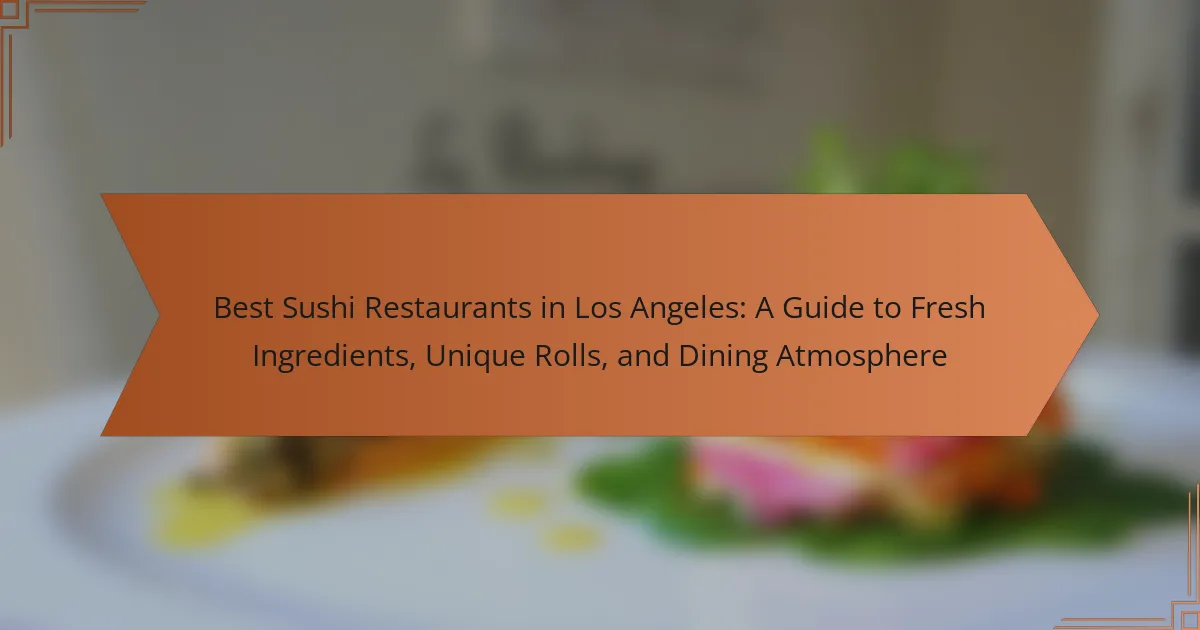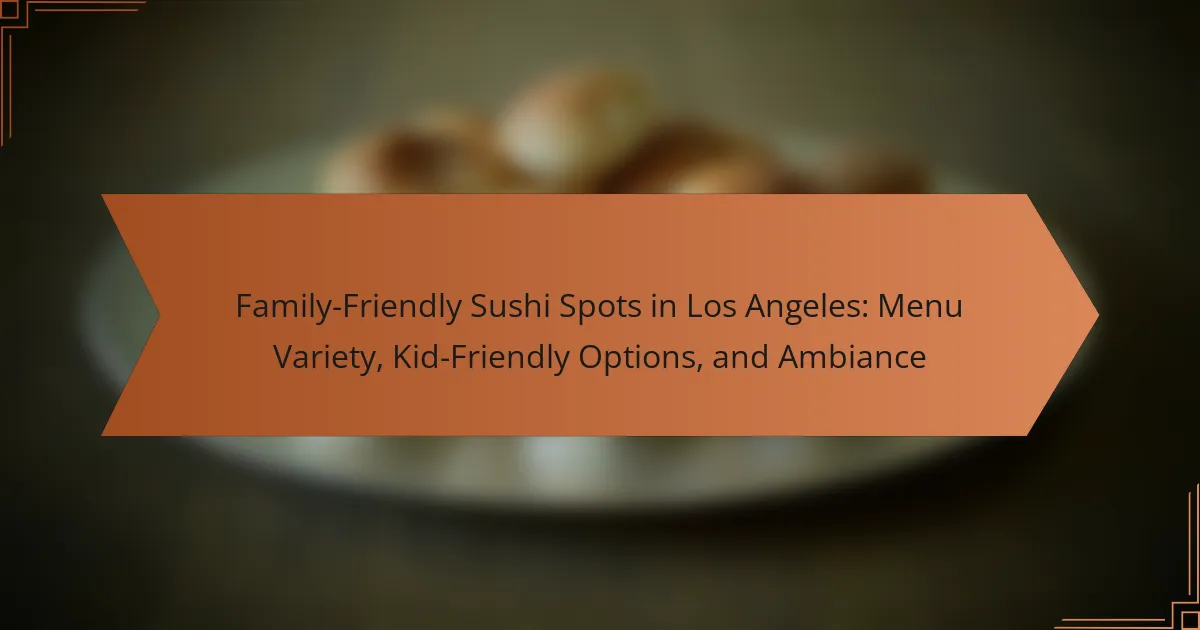Sushi is a prominent culinary entity in Los Angeles, reflecting the city’s rich diversity and innovative food culture. The article explores the significance of sushi within the local gastronomic scene, highlighting over 2,000 sushi restaurants that blend traditional Japanese techniques with fresh, local ingredients. It examines signature dishes, cultural influences, and notable chefs who contribute to the evolving sushi landscape. Additionally, the article discusses how sushi has impacted dining habits and represents a cultural exchange between Japanese traditions and American tastes, underscoring its vital role in Los Angeles’ culinary identity.

What is the significance of sushi in Los Angeles cuisine?
Sushi holds significant importance in Los Angeles cuisine as it reflects the city’s diverse culinary landscape. The fusion of traditional Japanese techniques with local ingredients has created unique sushi variations. Los Angeles is home to over 2,000 sushi restaurants, showcasing its popularity. The city’s proximity to the Pacific Ocean ensures fresh seafood availability. This access to quality ingredients enhances the sushi experience. Additionally, sushi represents cultural exchange, bridging Japanese traditions with American dining trends. The growth of sushi bars has influenced local food culture and dining habits. Overall, sushi is a vital component of Los Angeles’ gastronomic identity.
How has sushi evolved in Los Angeles over the years?
Sushi in Los Angeles has evolved significantly since its introduction in the early 20th century. Initially, sushi was primarily served in Japanese restaurants catering to the local community. The 1980s marked a turning point with the rise of sushi bars, making sushi more accessible to the general public. This period saw the introduction of the California roll, which popularized sushi among non-Japanese consumers.
The 1990s and 2000s brought further innovation with fusion sushi, incorporating local ingredients and flavors. Chefs began experimenting with unconventional rolls, such as the spicy tuna and tempura rolls. Today, Los Angeles boasts a diverse sushi scene, featuring traditional Edomae-style sushi alongside modern interpretations.
The city is home to renowned sushi chefs who have elevated the craft, such as Kazunori Nozawa and Katsuya Uechi. This evolution reflects a blend of cultural influences and culinary creativity, making Los Angeles a sushi destination. The city’s sushi landscape continues to grow, with new trends and techniques emerging regularly.
What cultural influences have shaped Los Angeles sushi?
Los Angeles sushi has been shaped by diverse cultural influences. The Japanese immigrant community introduced traditional sushi techniques in the early 20th century. Over time, these techniques blended with local ingredients and culinary styles. The influence of California cuisine is evident in the use of fresh, seasonal produce. Fusion styles emerged, incorporating flavors from Latin American and Asian cuisines. Notable examples include the California roll, which features avocado and crab. The city’s multicultural landscape has encouraged innovation in sushi offerings. Celebrity chefs and restaurants have further popularized unique sushi creations. This dynamic interplay of cultures continues to evolve Los Angeles sushi today.
How does the local seafood availability impact sushi styles?
Local seafood availability significantly influences sushi styles. Regions with abundant seafood offer fresher options for sushi preparation. In Los Angeles, local fisheries provide a variety of fish, shellfish, and seaweed. This access leads to unique sushi creations that reflect local tastes. For example, chefs may incorporate locally sourced ingredients like California roll, which features avocado and crab. The freshness of local seafood enhances flavor profiles in sushi dishes. Seasonal availability also dictates which seafood is featured in sushi menus. Chefs adapt their styles based on what is freshly caught or harvested nearby. This results in a dynamic sushi scene that evolves with the local marine ecosystem.
What are the defining characteristics of Los Angeles sushi?
Los Angeles sushi is characterized by its fusion of traditional Japanese techniques and local ingredients. This style often incorporates fresh, seasonal produce from California. Unique flavor combinations are common, blending Asian and American culinary influences. Sushi rolls, known as ‘makis’, often feature unconventional fillings such as avocado and cream cheese. The use of sustainable seafood is a notable trend among many LA sushi chefs. Many establishments emphasize presentation, making sushi visually appealing. The diverse cultural landscape of Los Angeles contributes to the variety of sushi styles available. Popular sushi spots often reflect the city’s vibrant food culture, showcasing creativity and innovation.
What unique ingredients are commonly used in LA sushi?
Unique ingredients commonly used in LA sushi include citrus-infused sauces, avocado, and spicy tuna. Citrus elements like yuzu enhance flavor profiles. Avocado adds creaminess and richness to rolls. Spicy tuna is a popular filling, often mixed with sriracha or mayo. Other ingredients include tempura flakes for crunch and unique toppings like truffle oil. These ingredients reflect LA’s diverse culinary influences. The incorporation of local produce also distinguishes LA sushi from traditional styles.
How do presentation styles differ in Los Angeles sushi restaurants?
Presentation styles in Los Angeles sushi restaurants vary significantly. Many establishments emphasize artistic plating that showcases the freshness of ingredients. For example, some restaurants use vibrant garnishes and elaborate arrangements. Others focus on minimalism, presenting sushi in a clean, uncluttered manner. This approach highlights the quality of the fish and rice.
Additionally, fusion restaurants often incorporate elements from other cuisines, leading to unique presentations. For instance, sushi tacos or sushi burritos are common in LA, reflecting a blend of culinary traditions. The diversity of the city’s population influences these styles, resulting in a wide range of aesthetic choices.
Overall, presentation styles in Los Angeles sushi restaurants reflect both traditional Japanese artistry and innovative culinary trends.
What are some signature sushi dishes unique to Los Angeles?
Los Angeles is known for its unique sushi dishes that blend traditional flavors with local influences. One signature dish is the “California Roll,” which features imitation crab, avocado, and cucumber. This roll originated in Los Angeles and became popular across the United States. Another notable dish is the “Spicy Tuna Roll,” often made with fresh tuna, spicy mayo, and scallions. This variation highlights the city’s emphasis on fresh seafood. The “Rainbow Roll” is also a staple, showcasing various fish on top of a California Roll base. Additionally, “Sushi Burritos” have gained popularity, combining sushi ingredients in a hand-held format. These dishes reflect LA’s innovative culinary scene and its diverse cultural influences.
What ingredients make the Rainbow Roll a standout dish?
The Rainbow Roll is distinguished by its vibrant combination of ingredients. It typically includes a California roll base, which consists of crab meat, avocado, and cucumber. Slices of fresh fish, such as tuna, salmon, and yellowtail, are layered on top. This colorful presentation enhances its visual appeal. The use of multiple fish varieties contributes to a rich flavor profile. Additionally, the roll is often garnished with sesame seeds or a drizzle of spicy mayo. These elements together create a unique dining experience, making the Rainbow Roll a popular choice in sushi restaurants.
How does the Spicy Tuna Tartare reflect LA’s culinary innovation?
The Spicy Tuna Tartare exemplifies LA’s culinary innovation through its fusion of flavors and techniques. This dish combines traditional Japanese ingredients with modern culinary practices. Chefs in Los Angeles often use high-quality, sustainably sourced tuna. The incorporation of spicy elements, like chili oil or sriracha, reflects a trend towards bold flavors. Additionally, the presentation of the tartare showcases artistic plating, appealing to the visual aspect of dining. This dish has become a staple in many LA sushi restaurants, highlighting the city’s diverse culinary landscape. The popularity of Spicy Tuna Tartare has influenced similar creations across the globe. Overall, it represents LA’s ability to blend cultural influences while pushing culinary boundaries.
How do chefs in Los Angeles influence the sushi scene?
Chefs in Los Angeles significantly influence the sushi scene through innovation and fusion. They incorporate local ingredients, creating unique flavor profiles. Many chefs blend traditional Japanese techniques with Californian culinary styles. This approach attracts a diverse clientele seeking new experiences. Notable chefs like David Chang and Nobu Matsuhisa have popularized this trend. Their restaurants often feature signature dishes that reflect cultural diversity. The sushi scene in Los Angeles has become a hub for creativity and experimentation. This evolution showcases the city’s dynamic food culture.
Who are the most notable sushi chefs in Los Angeles?
Notable sushi chefs in Los Angeles include Kazunori Nozawa, known for his omakase experience. Another prominent chef is Katsuya Uechi, famous for his innovative sushi dishes. Chef Niki Nakayama is celebrated for her kaiseki-style sushi. Additionally, chef Hiroyuki Naruke has gained recognition for his traditional techniques at Sushi Zo. These chefs have significantly influenced the sushi scene in Los Angeles through their unique styles and dedication to quality. Their establishments consistently receive high praise from food critics and patrons alike.
What techniques do these chefs employ to create signature dishes?
Chefs employ various techniques to create signature dishes, enhancing flavor and presentation. They utilize precise knife skills for sushi preparation, ensuring uniform cuts and texture. Marinades and sauces are crafted to complement the freshness of ingredients. Techniques like sous-vide cooking are applied for perfect temperature control. Fermentation methods are also used to develop unique flavors in sauces and toppings. Plating techniques are emphasized to create visually appealing presentations. These methods reflect cultural influences and personal styles, contributing to each chef’s unique signature.
What role does fusion play in Los Angeles sushi?
Fusion plays a significant role in Los Angeles sushi by blending traditional Japanese techniques with diverse culinary influences. This city is known for its multicultural environment, which encourages creativity in food preparation. Chefs often incorporate local ingredients and flavors from various cuisines, such as Mexican, Korean, and American. For example, sushi burritos and spicy tuna tacos are popular items that showcase this fusion. The innovative combinations attract a wide range of customers, enhancing the sushi dining experience. This trend reflects the city’s dynamic food culture and its ability to adapt traditional dishes to contemporary tastes.
How do fusion dishes reflect the diversity of LA’s population?
Fusion dishes reflect the diversity of LA’s population by blending various culinary traditions. Los Angeles is home to a multicultural community with significant populations from Asia, Latin America, and Europe. This diversity inspires chefs to create innovative dishes that combine ingredients and techniques from different cultures. For example, sushi burritos merge Japanese sushi with Mexican burrito styles. Additionally, Korean tacos fuse Korean barbecue flavors with traditional Mexican street food. These dishes showcase the city’s rich cultural tapestry. The prevalence of food trucks and fusion restaurants in LA further highlights this culinary creativity. According to the Los Angeles Times, the city’s food scene is a reflection of its diverse demographics and vibrant immigrant communities.
What are some popular fusion sushi dishes found in the city?
Popular fusion sushi dishes in Los Angeles include the Rainbow Roll, which features various types of fish on top of a California roll. The Crunchy Roll is another favorite, combining shrimp tempura with spicy mayo and eel sauce. The Spicy Tuna Tartare is a dish that blends traditional sushi with avocado and sesame flavors. Additionally, the Sushi Burrito offers a unique take, wrapping sushi ingredients in a large tortilla-like format. Many restaurants also serve the Lobster Roll, incorporating fresh lobster with traditional sushi rice. These dishes highlight the city’s diverse culinary influences and innovative approaches to sushi.
How can one experience the best sushi in Los Angeles?
To experience the best sushi in Los Angeles, one should visit renowned sushi restaurants known for their quality and authenticity. Establishments like Sushi Gen and Nozawa Bar are celebrated for their fresh ingredients and skilled chefs. Dining at these locations often requires reservations due to their popularity. Additionally, exploring sushi omakase experiences can provide a unique tasting journey. Many top chefs curate personalized menus that showcase seasonal ingredients. Engaging with knowledgeable staff can enhance the experience through recommendations. Los Angeles is home to diverse sushi styles, reflecting various cultural influences. Therefore, trying different types of sushi, such as nigiri and sashimi, can offer a comprehensive experience.
What tips should diners consider when choosing a sushi restaurant?
Consider the quality of fish when choosing a sushi restaurant. Freshness is crucial for sushi. Look for restaurants that source fish from reputable suppliers. Check for customer reviews regarding fish quality. Evaluate the chef’s experience and skill level. Experienced chefs often have better knife skills and presentation. Assess the cleanliness of the restaurant. A clean environment indicates good hygiene practices. Observe the variety of sushi offered. A diverse menu can indicate a well-rounded sushi experience. Lastly, consider the restaurant’s ambiance and service quality. A welcoming atmosphere enhances the dining experience.
How can culinary tours enhance the sushi tasting experience?
Culinary tours enhance the sushi tasting experience by providing expert guidance and cultural context. Participants learn about the history and significance of sushi. This knowledge enriches their appreciation of the flavors and techniques involved. Tours often include visits to renowned sushi chefs and establishments. Engaging with chefs allows for firsthand insights into their craft. Additionally, culinary tours often feature tastings of unique, regional sushi variations. This exposure broadens the participants’ palate and understanding of sushi diversity. Overall, culinary tours create a more immersive and educational experience for sushi lovers.
The main entity of the article is sushi within the context of Los Angeles cuisine. This article explores the significance of sushi as a reflection of the city’s diverse culinary landscape, detailing its evolution from traditional Japanese roots to modern fusion variations. Key topics include the cultural influences that shape sushi styles, the impact of local seafood availability on ingredient choices, and the defining characteristics of Los Angeles sushi, such as unique dishes and innovative presentation styles. Additionally, the article highlights notable sushi chefs and their contributions to the evolving sushi scene, as well as tips for experiencing the best sushi in the city.



